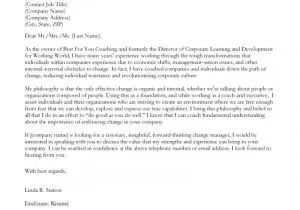Why Your Cover Letter Matters
In the competitive landscape of job applications, a well-crafted cover letter can be your golden ticket to landing an interview. It’s often the first impression you make on a potential employer, providing a crucial opportunity to showcase your personality, passion, and qualifications beyond the confines of your resume. Unlike a resume, which simply lists your experience and skills, a cover letter allows you to tell a story, explaining why you’re the perfect fit for the role and the company. A strong cover letter demonstrates your genuine interest in the position and allows you to highlight specific achievements and skills relevant to the job description. It provides context to your resume, helping the hiring manager understand the value you bring to the table. Failing to submit a cover letter when one is requested can be a missed opportunity, signaling a lack of attention to detail or a lack of genuine interest. Conversely, a compelling cover letter can elevate your application, setting you apart from other candidates and increasing your chances of getting noticed. It’s a chance to make a memorable first impression and convince the employer to delve deeper into your qualifications, ultimately leading to an interview and potentially, a job offer.
What to Include in Your Cover Letter
Crafting a cover letter that captures attention involves including several key elements. Begin with a professional heading that includes your contact information and the date, followed by the recipient’s details. Start with a compelling opening paragraph that immediately grabs the reader’s attention. Clearly state the position you’re applying for and where you found the job posting. In the body of your letter, highlight your most relevant skills and experiences, providing specific examples of your accomplishments and how they align with the job requirements. Demonstrate your understanding of the company and the role by referencing specific aspects of the job description and explaining how your skills and experience can contribute to their success. Quantify your achievements whenever possible, using numbers and data to showcase your impact. Make sure to clearly articulate your value proposition what you can bring to the company and why you’re the best candidate. Finally, end with a strong call to action, expressing your enthusiasm for the opportunity and stating your availability for an interview. Always proofread your cover letter carefully to ensure it’s free of errors and tailored to the specific job and company.
Highlighting Your Skills and Achievements

Your cover letter is an excellent platform to showcase your skills and achievements in a way that directly relates to the job requirements. Instead of merely listing your skills, provide concrete examples of how you’ve utilized them in previous roles. This is where you can demonstrate the value you bring. Quantify your achievements with numbers, data, or specific results. For instance, rather than saying ‘Managed social media accounts,’ you could write ‘Increased social media engagement by 30% within six months by implementing targeted content strategies.’ Use action verbs to describe your accomplishments. Focus on the skills and experiences that are most relevant to the job. Research the company and the role to identify the key skills and qualifications they’re looking for. Tailor your cover letter to align with these requirements by highlighting your corresponding skills and experiences. This helps you stand out as a candidate who not only has the necessary qualifications but also understands what the company needs. It’s crucial to show, not just tell, by backing up your claims with evidence and ensuring your examples are concise, clear, and compelling.
Tailoring Your Cover Letter to Each Job
One of the most effective strategies for creating an impressive cover letter is to customize it for each job you apply for. Generic cover letters that are sent to multiple companies will often lack the specific details that hiring managers look for. Begin by thoroughly reviewing the job description. Identify the key skills, qualifications, and responsibilities that the employer is seeking. Use the job description as a guide to tailor your cover letter. Address the specific requirements and highlight the skills and experiences that align with the role. This shows the employer that you understand their needs and that you’ve taken the time to consider how you fit into the company. Research the company. Learn about its mission, values, and recent projects. Showcasing this knowledge in your cover letter demonstrates your genuine interest and your understanding of the company’s culture and goals. Personalize your cover letter. Address the hiring manager by name, if possible. Use the company’s name throughout the letter and reference specific details from their website or social media pages. By customizing your cover letter, you communicate that you’re genuinely interested in the position and that you have the qualifications and understanding to excel in the role. This personalized approach significantly increases your chances of capturing the hiring manager’s attention and securing an interview.
Formatting Your Cover Letter for Readability
A well-formatted cover letter is easy to read and visually appealing, ensuring that your message is effectively conveyed. Begin with a clear and professional heading that includes your contact information. Use a standard business letter format, which typically includes the date, the recipient’s name and title, and the company’s address. Choose a readable font such as Times New Roman, Arial, or Calibri, with a font size between 10 and 12 points. Maintain consistent formatting throughout the document to create a polished look. Use single spacing within paragraphs and double spacing between paragraphs. Use clear and concise language, avoiding jargon or overly complex sentences. Keep your paragraphs short and focused, making it easier for the hiring manager to scan the document. Use bullet points to highlight key achievements or skills, breaking up large blocks of text and making the information more accessible. Ensure your cover letter is well-organized, with a clear introduction, body paragraphs, and conclusion. The goal is to present your information in a way that is easy for the reader to follow. A well-formatted cover letter demonstrates your attention to detail and professionalism, leaving a positive impression on the employer.
Cover Letter Language and Tone

The language and tone of your cover letter play a crucial role in how your application is received. Maintain a professional tone throughout the letter. Avoid overly casual language or slang. Use formal but friendly language. Write in a confident and enthusiastic tone, showcasing your passion for the role and the company. Convey your personality and enthusiasm in your writing, but always maintain a level of professionalism. Use active voice, which makes your writing more direct and engaging. Be concise and clear, avoiding unnecessary jargon or overly complex sentences. Focus on the benefits you can bring to the company, highlighting your skills and achievements in a way that emphasizes your value. Tailor your tone to the specific company and industry. Research the company’s culture and values to ensure your tone aligns with their expectations. Use positive language throughout your cover letter. Avoid negative statements or phrases that might detract from your message. The goal is to present yourself in a positive and professional light, making the employer want to learn more about you. By carefully selecting your language and tone, you can create a cover letter that grabs the reader’s attention and makes a positive impact.
Proofreading and Editing Your Cover Letter
Proofreading and editing your cover letter is a critical step in ensuring it effectively represents your skills and qualifications. Errors in grammar, spelling, or punctuation can undermine your credibility and make a negative impression on the hiring manager. Before submitting your cover letter, carefully proofread it for any errors. Use a spell checker and grammar checker to catch common mistakes. However, don’t rely solely on these tools. Read your cover letter aloud. This can help you identify awkward phrasing, grammatical errors, and other issues that might be missed when reading silently. Ask a friend, family member, or career counselor to review your cover letter. A fresh pair of eyes can often catch errors you might have overlooked. Ensure your cover letter is concise and clear. Cut out any unnecessary words or phrases. Make sure the formatting is consistent and visually appealing. Use a professional tone and language, avoiding slang or overly casual expressions. The more polished and error-free your cover letter, the more professional you will appear. Proofreading and editing are crucial steps in making sure your cover letter stands out for the right reasons.
Closing Your Cover Letter Effectively
The closing of your cover letter is a crucial opportunity to reinforce your interest and leave a lasting impression. Start by expressing your enthusiasm for the opportunity. Reiterate your interest in the position and reiterate your value proposition. In a concise manner, summarize why you are the ideal candidate, highlighting your key skills and experiences. Clearly state your availability for an interview and express your willingness to discuss your qualifications further. Include a call to action, such as, “I look forward to the possibility of discussing my application further,” or “I am eager to learn more about this opportunity.” Use a professional closing such as “Sincerely,” “Respectfully,” or “Best regards.” Followed by your typed name. Double-check all contact information to ensure it is accurate. By ending on a positive and proactive note, you increase your chances of securing an interview and advancing in the job application process. A strong close leaves the employer with a positive and memorable impression.
